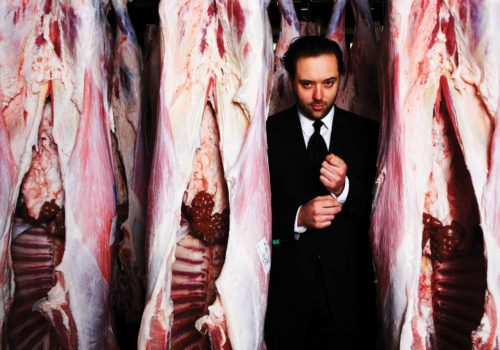There was a moment when Melanie Dunea wondered if her work had gone too far. The New York City-based photographer was in Montreal, Canada to shoot two chefs, David McMillan and Frédéric Morin, who as a team go by the name Joe Beef. That is also the name of their popular restaurant near the city’s historic Atwater market, which would have been a charming setting for a picture. Dunea, however, was shooting them in an abandoned railroad yard, where the two chefs, propped up against a snow bank as the dark Canadian evening settled in, drank moonshine from a homemade still.
“They told me they had to teach me how to make moonshine,” says Dunea. The sketchy scene grew more alarming when the railroad yard’s groundskeeper showed up with his pet squirrel in a cage. “I said, ‘this squirrel needs to be in my shot,’” says Dunea. “It was fun, but I was worried I’d get caught with the moonshine, which is illegal. I thought I’d never be allowed to get home.”
Return she did, without having learned the techniques of moonshine production. But Dunea, a veteran portrait photographer with a habit of making friends, had the picture she wanted, and she has included it in her just-released book, My Last Supper: The Next Course (Rodale, $39.99). It’s a sequel to her hit 2007 book My Last Supper, in which 50 of the world’s most respected chefs revealed what they would have for their final meal on earth.
“I loved asking all these different people the same question and then finding out what they had to say,” says Dunea. “It seemed to reveal so much about their characters.” The idea for the first book came out a project she shot for late, lamented Gourmet magazine, which hired Dunea to shoot portraits of renowned chefs for a series of trading cards that readers could collect—a kind of fantasy league for foodies. “This was just when chefs were becoming television celebrities,” says Dunea. She later approached a dozen publishers with her “last supper” idea, but most either didn’t understand it—“they thought it sounded morbid,” Dunea says—or they didn’t recognize the public’s growing fascination with chefs and cooking. In the end the book sold out its 25,000-copy first run. Ironically, when Dunea pitched her sequel in 2010 what she heard from most publishers was “that the whole chef thing was over.”
Not really. The New York Times recently noted that the popularity of food and cooking shows on American television shows no signs of slacking off. Ratings for cable television’s Food Network have been trending higher since 2009, and the channel tied its own ratings record in September. Meanwhile new food and cooking shows are showing up all over, including a new daytime talk show on ABC called “The Chew.”
“There were all these chefs I didn’t get to include in the first book,” says Dunea. They included celebrity TV chefs like Bobby Flay, as well as the venerated old guard of haut cuisine like Paul Bocuse and next-generation super-chefs like Grant Achatz. She shot the book in nine months—between January and April of 2011, Dunea logged 85,000 air miles, traveling to Paris, London, Mexico City, Sao Paulo, and other cities to interview and photograph chefs. She took along one assistant and produced each shoot by herself.
“I think one of reasons I adore the chef world is that their job is so similar to mine,” says Dunea. “Their job isn’t glamorous, though most people think it’s glamorous. It’s the same with photography. Most people don’t realize how physical both jobs are. Photographers are dragging equipment around, often outside in the heat or getting rained on, and chefs work long, long hours in hot kitchens, always moving.”
Physical effort aside, Dunea faced the creative challenge of photographing 50 chefs in ways that would reveal their individual natures: After a while, everyone wearing a white smock will inevitably begin to look alike, and there are only so many times you can show someone holding a knife. So there is Bocuse, captured in a triptych formed by the doors of his restaurant in Lyon, France, his son Jerome to his right and his young grandson, Petit Paul, gazing up admiringly from his left.
And there is New Orleans chef John Besh, standing on a boat dock in a Louisiana bayou at 5:00 in the morning. “It was so hot. And there were snakes,” recalls Dunea. And Albert Roux, distractedly sipping down his morning coffee at a table of London’s Le Gavroche restaurant. And Achatz, who recently published a brilliant memoir about his battle with tongue cancer and its effects on his sense of taste. Dunea rejected the temptation to show Achatz’s tongue—“it would be completely disrespectful,” she says—and instead photographed him in profile, his full face reflected unevenly in a strip of mylar.
With the new book finally out, Dunea is taking her “last supper” concept further—she has launched a website, MyLastSupper.com, which combines photos, recipes, and videos (shot by her husband, the photographer Nigel Parry) featuring Dunea talking with chefs about their perfect last meals. And she will soon be hosting a series of last-supper interviews on Martha Stewart’s Sirius/XM-Radio satellite radio channel. “I’ll probably just bring in some candy for us to nibble on while we talk,” she says.
David Schonauer
















